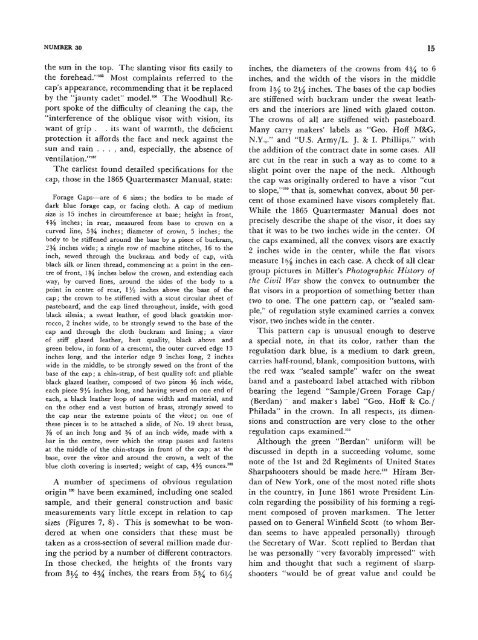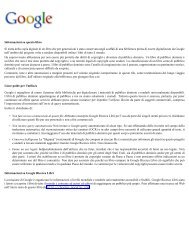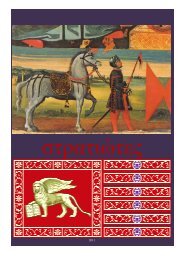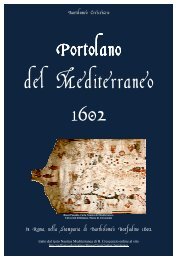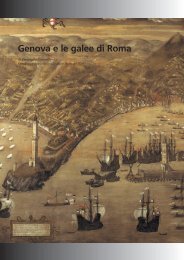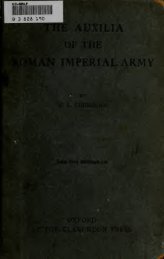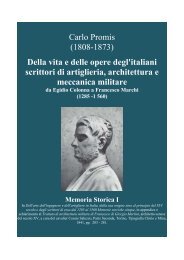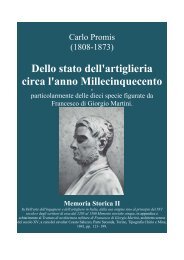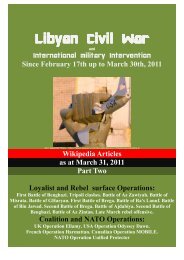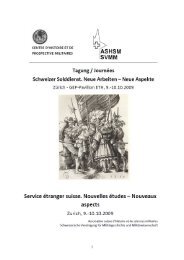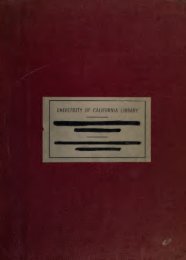14 SMITHSONIAN STUDIES IN HISTORY AND TECHNOLOGYWar is desirous of introducing the accompanyingcap as a 'forage cap' for enlisted men and directsyou report the cost of it ... . The color of the weltaround the crown is to correspond in color withthe facings of the corps . . ."°' Three days laterThomas acknowledged the communication, givingan estimate of the cost, and returned the cap he hadbeen sent together with two caps made at thearsenal, apparently of the engineer pattern, remarkingthat the only difference between the two patternswas in the visor. The letter, forwarded on tothe Secretary of War, was returned to Jesup on 1December endorsed: "Respectfully returned withthree caps and a copy of General Order No. 13 ofthis date. The style of the cap is to be exactly similarto the sample with the orange colored welt,without stiffenings or stitched bands, the visor howeverto be of the pattern described within as beingcut to slope.""' The same day Jesup wrote Thomas,enclosing a copy of General Order No. 13 and theAdjutant General's endorsement, and adding that"the cap adopted was made in Baltimore underBt. Major French's direction . . . ." and that thesample was to be followed in every particular "withthe exception of the modifications ordered."""A week later, Jesup wrote a rather curiouslyworded letter to Thomas:The stiffening or staying of the cap, that you suggest, wasurged against the Engineer caps you sent on, by those havingthe matter in hand, and the absence of anything of thekind, in the cap adopted, was claimed, as an advantage in it.As our advice has not been sought in the matter, and adecision made without our consultation, I am not disposed tooffer any suggestions, but to carry out the instructions givento me, and to leave the test of the Secretary's adoption topractical experience.If what you apprehend should occur, the <strong>Army</strong> will makeit known, and it can be remedied."'From this it would seem that although the engineercap and the patterns submitted by MajorFrench were very similar in general appearance, theformer had some stiffening in addition to that inthe crown plus the "stitched bands" (whatever theymay have been) and also a visor "cut to slope," orconvex, this latter being adopted for French'smodel. This is further borne out by the fact that inthe list of materials used in making the engineercap, the cost of the fuller's board, id est, paperboard, was set at $.05, and $.05 will buy a good bitof fuller's board. Thus, the cap adopted apparentlywas a combination of the body of French's cap andthe visor of the engineer model.Actually, in more than one sense, French's caphad its inspiration in the 1851 model, for the twoare quite similar in measurement: the height ofthe front and back and the diameter of the topaveraging 6, 7i/2, and bY^ inches respectively, in theearlier pattern, and 4, 6i/^, and 534 inches in thelater model. If one took out the cap body, or stiffening,as French's men did, he would have a capvery similar to that adopted. In matter of fact, inApril 1859, the Quartermaster General directedthat all caps of the earlier pattern were to be issuedas forage caps and, one would judge, withthe bodies, or stiffening, removed."'General Order No. 13 stated:For fatigue purposes Forage Caps, of pattern in the QuartermasterGeneral's Office, will be issued, in addition to hats,at the rate of one a year. Dark blue cloth, with a cord orwelt around the crown of the colors used to distinguish theseveral arms of service, and yellow metal letters in front todesignate companies. For unassigned recruits dark blue cordor welt around the crown and without distinctive badge.Commissioned officers may wear caps of the same patternwith dark blue welt and the distinctive ornament, in front,of the corps and regiment.""The sizes of the insignia were not given, but the1861 uniform regulations specified the number ofthe regiment and the letter of the company wornon the hat as 5/^ inch and 1 inch high, respectively,and it seems probable that these same were used onthe cap."" The sizes of the corps device for officersare nowhere given. Although the author has neverseen or heard of an authentic regulation issue capwith the colored welt, there is no question that theywere issued, the first such issue being ordered asearly as 16 December 1858, 84 caps for Company E,1st Infantry, and in January caps specifically forinfantry, engineers, and artillery."' The caps weremanufactured at Schuylkill Arsenal at an initialcost of $.85, the cost dropping to $.57 a year later.'"'General Order No. 4 of 26 February 1861 broughtan end to the colored welt, stating that thereafterforage caps were to be made with a dark bluewelt like that originally prescribed for vmassignedrecruits."'Criticism of the cap varied from good to bad, butnowhere was it attacked so violently as the campaignhat. One complained that it was a "waste ofcloth, too baggy, and caught the wind,""* whileanother called it "useful and even natty" thoughnot particularly beautiful. "No other cap is socomfortable. There is room for a wet sponge, greenleaves, a handkerchief, or other protection against
NUMBER 30 15the sun in the top. The slanting visor fits easily tothe forehead.""" Most complaints referred to thecap's appearance, recommending that it be replacedby the "jaunty cadet" model.'"" The Woodhull Reportspoke of the difficulty of cleaning the cap, the"interference of the oblique visor with vision, itswant of grip . . its want of warmth, the deficientprotection it affords the face and neck against thesun and rain . . . , and, especially, the absence ofventilation.""'The earliest found detailed specifications for thecap, those in the 1865 Quartermaster Manual, state:Forage Caps—are of 6 sizes; the bodies to be made ofdark blue forage cap, or facing cloth. A cap of mediumsize is 15 inches in circumference at base; height in front,4^ inches; in rear, measured from base to crown on acurved line, 5^4 inches; diameter of crown, 5 inches; thebody to be stiffened around the base by a piece of buckram,2% inches wide; a single row of machine stitches, 16 to theinch, sewed through the buckram and body of cap, withblack silk or linen thread, commencing at a point in the centreof front, 1 Yi inches below the crown, and extending eachway, by curved lines, around the sides of the body to apoint in centre of rear, 1 /a inches above the base of thecap; the crown to be stiffened with a stout circular sheet ofpasteboard, and the cap lined throughout, inside, with goodblack silesia; a sweat leather, of good black goatskin morrocco,2 inches wide, to be strongly sewed to the base of thecap and through the cloth buckram and lining; a vizorof stiff glazed leather, best quality, black above andgreen below, in form of a crescent, the outer curved edge 13inches long, and the interior edge 9 inches long, 2 incheswide in the middle, to be strongly sewed on the front of thebase of the cap; a chin-strap, of best quality soft and pliableblack glazed leather, composed of two pieces Ys inch wide,each piece 9/2 inches long, and having sewed on one end ofeach, a black leather loop of same width and material, andon the other end a vest button of brass, strongly sewed tothe cap near the extreme points of the vizor; on one ofthese pieces is to be attached a slide, of No. 19 sheet brass,Ys of an inch long and % of an inch wide, made with abar in the centre, over which the strap passes and fastensat the middle of the chin-straps in front of the cap; at thebase, over the vizor and around the crown, a welt of theblue cloth covering is inserted; weight of cap, 4% ounces."'A number of specimens of obvious regulationorigin '"" have been examined, including one sealedsample, and their general construction and basicmeasurements vary little except in relation to capsizes (Figures 7, 8). This is somewhat to be wonderedat when one considers that these must betaken as a cross-section of several million made duringthe period by a number of different contractors.In those checked, the heights of the fronts varyfrom 314 to 43^ inches, the rears from 5.^ to 6i/^inches, the diameters of the crowns from 4^ to 6inches, and the width of the visors in the middlefrom lYs to 2i/^ inches. The bases of the cap bodiesare stiffened with buckram under the sweat leathersand the interiors are lined with glazed cotton.The crowns of all are stiffened with pasteboard.Many carry makers' labels as "Geo. Hoff M&G,N.Y.,." and "U.S. <strong>Army</strong>/L. J. & I. Phillips," withthe addition of the contract date in some cases. Allare cut in the rear in such a way as to come to aslight point over the nape of the neck. Althoughthe cap was originally ordered to have a visor "cutto slope,""" that is, somewhat convex, about 50 percentof those examined have visors completely flat.While the 1865 Quartermaster Manual does notprecisely describe the shape of the visor, it does saythat it was to be two inches wide in the center. Ofthe caps examined, all the convex visors are exactly2 inches wide in the center, while the flat visorsmeasure lYs inches in each case. A check of all cleargroup pictures in Miller's Photographic History ofthe Civil War show the convex to outnumber theflat visors in a proportion of something better thantwo to one. The one pattern cap, or "sealed sample,"of regulation style examined carries a convexvisor, two inches wide in the center.This pattern cap is unusual enough to deservea special note, in that its color, rather than theregulation dark blue, is a medium to dark green,carries half-round, blank, composition buttons, withthe red wax "sealed sample" wafer on the sweatband and a pasteboard label attached with ribbonbearing the legend "Sample/Green Forage Cap/(Berdan) and maker s label "Geo. Hoff & Co./Philada" in the crown. In all respects, its dimensionsand construction are very close to the otherregulation caps examined."'Although the green "Berdan" uniform will bediscussed in depth in a succeeding volume, somenote of the 1st and 2d Regiments of <strong>United</strong> <strong>States</strong>Sharpshooters should be made here."' Hiram Berdanof New York, one of the most noted rifle shotsin the country, in June 1861 wrote President Lincolnregarding the possibility of his forming a regimentcomposed of proven marksmen. The letterpassed on to General Winfield Scott (to whom Berdanseems to have appealed personally) throughthe Secretary of War. Scott replied to Berdan thathe was personally "very favorably impressed" withhim and thought that such a regiment of sharpshooters"would be of great value and could be
- Page 1: • ^ - :lP-'L^ry\'^ ^iT
- Page 4 and 5: ABSTRACTHowell, Edgar M. United Sta
- Page 7 and 8: ContentsPagePrefaceiiiThe 1855 Cava
- Page 9 and 10: United States Army Headgear 1855-19
- Page 11 and 12: NUMBER 30report, stated: "The hat p
- Page 13 and 14: NUMBER 30acorns %g inches long and
- Page 15 and 16: NUMBER 30the pattern." The rate of
- Page 17 and 18: NUMBER 30FIGURE 3.—1858 Army hat.
- Page 19 and 20: NUMBER 3011model, number 60 in the
- Page 21: NUMBER 30 13"the desired modificati
- Page 25 and 26: NUMBER 30 17FIGURE 8.—1858 forage
- Page 27 and 28: NUMBER 30 19Hardtack and Coffee, ca
- Page 29 and 30: NUMBER 3021FIGURE 11.—a, Brigadie
- Page 31 and 32: NUMBER 30 23short "shell" jacket "f
- Page 33 and 34: NUMBER 30 26broad, securely soldere
- Page 35 and 36: NUMBER 30 27worn in the picture wer
- Page 37 and 38: NUMBER 30 29This communication elic
- Page 39 and 40: NUMBER 30 31FIGURE 17.—"The [Scot
- Page 41 and 42: NUMBER 30 33time for issue in the c
- Page 43 and 44: NUMBER 30 35be at too great a dista
- Page 45 and 46: NUMBER 3037half (5/2) part of washb
- Page 47 and 48: NUMBER 30 39trimmings for all enlis
- Page 49 and 50: NUMBER 30 41ing the upper space for
- Page 51 and 52: NUMBER 30rear one to a correspondin
- Page 53 and 54: NUMBER 30 46FIGURE 29.—1872 enlis
- Page 55 and 56: NUMBER 3047FIGURE 32.—^The Bent &
- Page 57 and 58: NUMBER 3049of strong split-leather
- Page 59 and 60: NUMBER 30 51''""MttfenFIGURE 35.—
- Page 61 and 62: NUMBER 30 53(which he thought might
- Page 63 and 64: NUMBER 30 55FIGURE 38.—Captain Be
- Page 65 and 66: NUMBER 30 57campaign hat for the Ar
- Page 67 and 68: NUMBER 30 59salvage something from
- Page 69 and 70: NUMBER 30 61hat. In June 1899 the P
- Page 71 and 72: NUMBER 3063the left side, pass diag
- Page 73 and 74:
NUMBER 30 65.LJU^.."*^..FIGURE 44.
- Page 75 and 76:
NUMBER 30 67to be sent to Washingto
- Page 77 and 78:
NUMBER 30 69with brass sliding-buck
- Page 79 and 80:
NUMBER 30 71FIGURE 48.—Officers'
- Page 81 and 82:
NUMBER 3073The adoption of the whit
- Page 83 and 84:
NUMBER 3075i >•^\Wiii I ifiiiniim
- Page 85 and 86:
NUMBER 30this last model made no pr
- Page 87 and 88:
NUMBER 30 79WAR DEPARTMENT,QUARTERM
- Page 89 and 90:
NUMBER 3081FIGURE 58.—1864 chapea
- Page 91 and 92:
NUMBER 30geon 1880 and Surgeon Gene
- Page 93 and 94:
NUMBER 3085FIGURE 63.—1895 forage
- Page 95 and 96:
NUMBER 30 87of not less than 9.24 g
- Page 97 and 98:
AppendixMAKERS OF HEADGEARThe chron
- Page 99 and 100:
List of AbbreviationsAAGAAQMAGAGOAQ
- Page 101 and 102:
NUMBER 3093all OQMG, LS, Clothing,
- Page 103 and 104:
NUMBER 30 95"Jesup to Thomas, 8 Dec
- Page 105 and 106:
NUMBER 3097OQMG, Reg. LR, Clothing,
- Page 107 and 108:
NUMBER 30 99October of 1870. See Me
- Page 109 and 110:
NUMBER 30 101'"* See above, pp. 35-
- Page 111 and 112:
NUMBER 30 103Monroe, Va., in 1878.
- Page 113 and 114:
NUMBER 30 105""Endorsement, 24 May
- Page 115 and 116:
ReferencesThe bulk of the source ma
- Page 117:
M MBIiR 30 10910, No. 355-10, 19 Se


